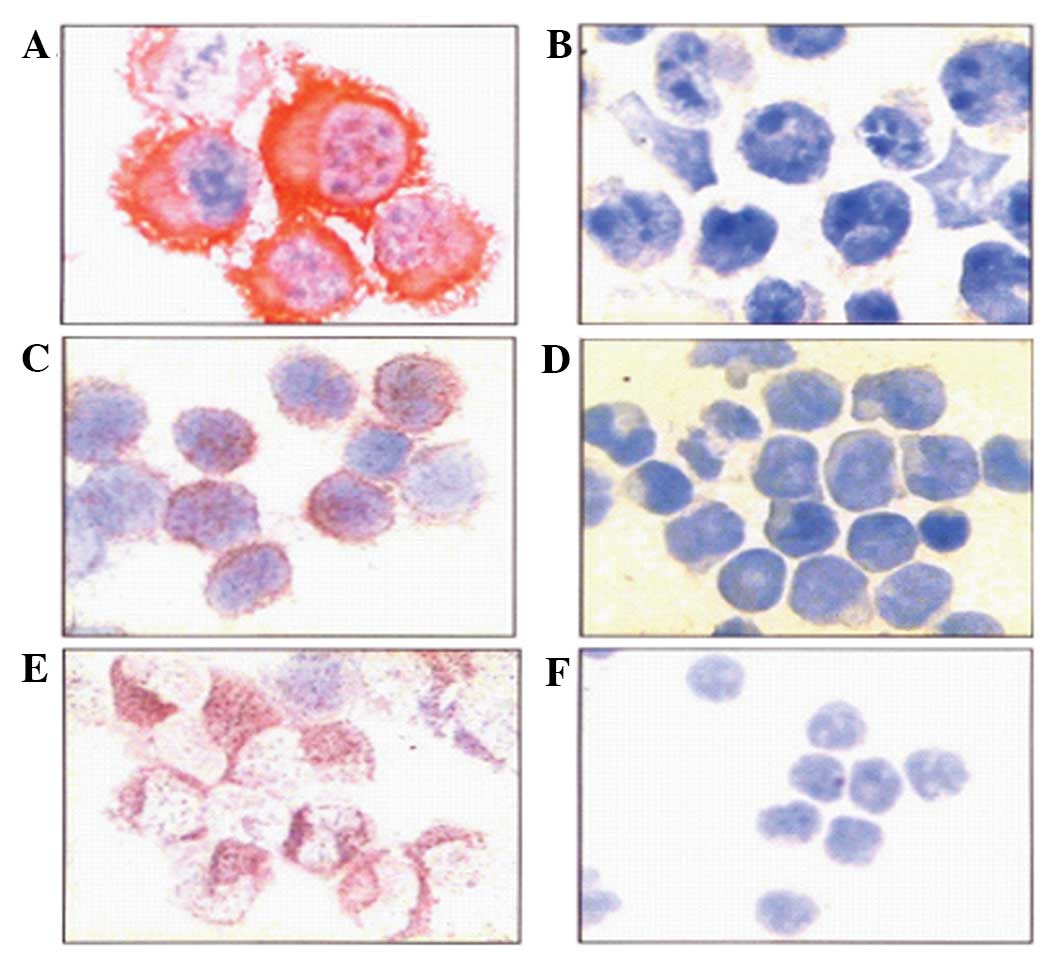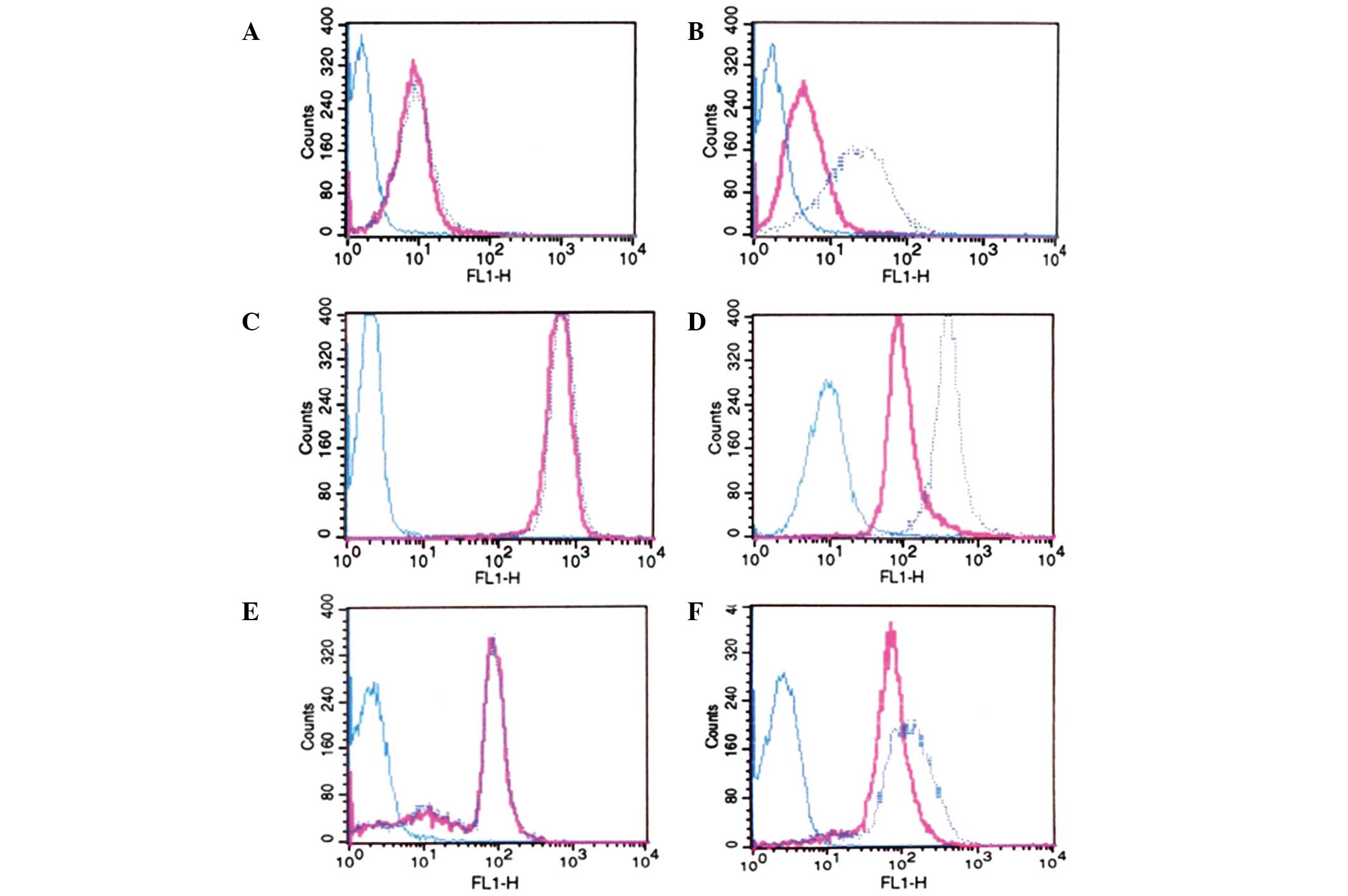|
1
|
Thomas H and Coley HM: Overcoming
multidrug resistance in cancer: an update on the clinical strategy
of inhibiting p-glycoprotein. Cancer Control. 10:159–165.
2003.PubMed/NCBI
|
|
2
|
Leith CP, Chen IM, Kopecky KJ, Appelbaum
FR, Head DR, Godwin JE, Weick JK and Willman CL: Correlation of
multidrug resistance (MDR1) protein expression with functional
dye/drug efflux in acute myeloid leukemia by multiparameter flow
cytometry: identification of discordant
MDR−/efflux+ and
MDR1+/efflux− cases. Blood. 86:2329–2342.
1995.PubMed/NCBI
|
|
3
|
Gao FZM, Liu Y and Sun K: Analyses of
expression and function of P-glycoprotein in relapsed/refractory
acute myelogenous leukemia patients. Journal of Leukemia &
Lymphoma. 15:419–421. 2006.(In Chinese).
|
|
4
|
Huls M, Russel FG and Masereeuw R: The
role of ATP binding cassette transporters in tissue defense and
organ regeneration. J Pharmacol Exp Ther. 328:3–9. 2009. View Article : Google Scholar
|
|
5
|
Mahadevan D and List AF: Targeting the
multidrug resistance-1 transporter in AML: molecular regulation and
therapeutic strategies. Blood. 104:1940–1951. 2004. View Article : Google Scholar : PubMed/NCBI
|
|
6
|
Lopes EC, Scolnik M, Alvarez E and Hajos
SE: Modulator activity of PSC 833 and cyclosporin-A in vincristine
and doxorubicin-selected multidrug resistant murine leukemic cells.
Leuk Res. 25:85–93. 2001. View Article : Google Scholar : PubMed/NCBI
|
|
7
|
Malmo J, Sandvig A, Vårum KM and Strand
SP: Nanoparticle mediated P-glycoprotein silencing for improved
drug delivery across the blood-brain barrier: a siRNA-chitosan
approach. PLoS One. 8:e541822013. View Article : Google Scholar : PubMed/NCBI
|
|
8
|
Aliabadi HM, Mahdipoor P and Uludağ H:
Polymeric delivery of siRNA for dual silencing of Mcl-1 and
P-glycoprotein and apoptosis induction in drug-resistant breast
cancer cells. Cancer Gene Ther. 20:169–77. 2013. View Article : Google Scholar : PubMed/NCBI
|
|
9
|
Haase D, Feuring-Buske M, Könemann S,
Fonatsch C, Troff C, Verbeek W, Pekrun A, Hiddemann W and Wörmann
B: Evidence for malignant transformation in acute myeloid leukemia
at the level of early hematopoietic stem cells by cytogenetic
analysis of CD34+ subpopulations. Blood. 86:2906–2912.
1995.PubMed/NCBI
|
|
10
|
Feller N, Schuurhuis GJ, van der Pol MA,
Westra G, Weijers GW, van Stijn A, Huijgens PC and Ossenkoppele GJ:
High percentage of CD34 positive cells in autologous AML peripheral
blood stem cell products reflects inadequate in vivo purging and
low chemotherapeutic toxicity in a subgroup of patients with poor
clinical outcome. Leukemia. 17:68–75. 2003. View Article : Google Scholar : PubMed/NCBI
|
|
11
|
Samdani A, Vijapurkar U, Grimm MA, Spier
CS, Grogan TM, Glinsmann-Gibson BJ and List AF: Cytogenetics and
P-glycoprotein (PGP) are independent predictors of treatment
outcome in acute myeloid leukemia (AML). Leuk Res. 20:175–180.
1996. View Article : Google Scholar : PubMed/NCBI
|
|
12
|
Zhu J, Chen Z, Lallemand-Breitenbach V and
de Thé H: How acute promyelocytic leukaemia revived arsenic. Nat
Rev Cancer. 2:705–713. 2002. View
Article : Google Scholar : PubMed/NCBI
|
|
13
|
Sun HD, Ma L, Hu XC and Zhang TD: Ai-ling
1 treated 32 cases of acute promyelocytic leukemia. Chin J Integrat
Trad Chin West Med. 12:21992.(In Chinese).
|
|
14
|
Chen GQ, Zhu J, Shi XG, Ni JH, Zhong HJ,
Si GY, Jin XL, Tang W, Li XS, Xong SM, et al: In vitro studies on
cellular and molecular mechanisms of arsenic trioxide
(As2O3) in the treatment of acute
promyelocytic leukemia: As2O3 induces NB4
cell apoptosis with downregulation of Bcl-2 expression and
modulation of PML-RAR alpha/PML proteins. Blood. 88:1052–1061.
1996.PubMed/NCBI
|
|
15
|
Zhang PWS, Hu LH, Shi FD, Qiu FQ, Hong GJ,
Han XY, Yang HF, Sun YZ, Liu YP, Zhao J and Jin ZJ: Treatment of 72
cases of acute promyelocytic leukemia with intravenous arsenic
trioxide. Chin J Hematol. 5:41996.(In Chinese).
|
|
16
|
Chen Z, Wang ZY and Chen SJ: Acute
promyelocytic leukemia: cellular and molecular basis of
differentiation and apoptosis. Pharmacol Ther. 76:141–149. 1997.
View Article : Google Scholar
|
|
17
|
Chen GQ, Shi XG, Tang W, Xiong SM, Zhu J,
Cai X, Han ZG, Ni JH, Shi GY, Jia PM, et al: Use of arsenic
trioxide (As2O3) in the treatment of acute
promyelocytic leukemia (APL): I. As2O3 exerts
dose-dependent dual effects on APL cells. Blood. 89:3345–3353.
1997.PubMed/NCBI
|
|
18
|
Zhang XW, Yan XJ, Zhou ZR, Yang FF, Wu ZY,
Sun HB, Liang WX, Song AX, Lallemand-Breitenbach V, Jeanne M, et
al: Arsenic trioxide controls the fate of the PML-RARalpha
oncoprotein by directly binding PML. Science. 328:240–243. 2010.
View Article : Google Scholar : PubMed/NCBI
|
|
19
|
Qiang L, Yang Y, Ma YJ, Chen FH, Zhang LB,
Liu W, Qi Q, Lu N, Tao L, Wang XT, et al: Isolation and
characterization of cancer stem like cells in human glioblastoma
cell lines. Cancer Lett. 279:13–21. 2009. View Article : Google Scholar : PubMed/NCBI
|
|
20
|
Zhao YFJ, Liang J, Chen B, Yao R, Shang Q
and Wang S: MDR reversing and apoptosis inducing effects on
treatment with arsenic trioxide in gastric cancer cell cine
SGC7901/ADM. Clin Oncol Cancer Res. 32:32005.(In Chinese).
|
|
21
|
Fuss IJ, Kanof ME, Smith PD and Zola H:
Isolation of whole mononuclear cells from peripheral blood and cord
blood. Curr Protoc Immunol. Chapter 7:2000.
|
|
22
|
Bennett JM, Catovsky D, Daniel MT,
Flandrin G, Galton DA, Gralnick HR and Sultan C: Proposals for the
classification of the acute leukaemias. French-American-British
(FAB) co-operative group. Br J Haematol. 33:451–458. 1976.
View Article : Google Scholar : PubMed/NCBI
|
|
23
|
Abd El-Ghaffar HA, Aladle DA, Farahat SE
and Abd El-Hady N: P-glycoprotein (P-170) expression in acute
leukemias. Hematology. 11:35–41. 2006. View Article : Google Scholar : PubMed/NCBI
|
|
24
|
Li X, Li J, Du W, Zhang J, Liu W, Chen X,
Li H, Huang S and Li X: Relevance of immunophenotypes to prognostic
subgroups of age, WBC, platelet count, and cytogenetics in de novo
acute myeloid leukemia. APMIS. 119:76–84. 2011. View Article : Google Scholar
|
|
25
|
Rao J, Xu DR, Zheng FM, Long ZJ, Huang SS,
Wu X, Zhou WH, Huang RW and Liu Q: Curcumin reduces expression of
Bcl-2, leading to apoptosis in daunorubicin-insensitive CD34+ acute
myeloid leukemia cell lines and primary sorted CD34+ acute myeloid
leukemia cells. J Transl Med. 9:712011. View Article : Google Scholar : PubMed/NCBI
|
|
26
|
Oelschlaegel U, Mohr B, Schaich M, Schäkel
U, Kroschinsky F, Illmer T, Ehninger G and Thiede C: HLA-DRneg
patients without acute promyelocytic leukemia show distinct
immunophenotypic, genetic, molecular, and cytomorphologic
characteristics compared to acute promyelocytic leukemia. Cytometry
B Clin Cytom. 76:321–327. 2009. View Article : Google Scholar : PubMed/NCBI
|
|
27
|
Gao FLY, Hou K and Sun K: The relationship
between age of AML patients and expression of P-gp. Chin J Prac Int
Med. 27:22007.(In Chinese).
|
|
28
|
Xue YW, Han JG, Li BX and Yang BF:
Reversal effect and mechanism of arsenic trioxide on multidrug
resistance of gastric carcinoma cells SGC7901. Yao Xue Xue Bao.
42:949–953. 2007.(In Chinese). PubMed/NCBI
|
|
29
|
Wang T, Ma LM, Zhang HP, Wang HW, Yang LH
and Qiao ZH: The effect of arsenic trioxide (As2O3) combined with
BSO on K562/ADM cell and its mechanisms. Zhonghua Xue Ye Xue Za
Zhi. 28:438–443. 2007.(In Chinese). PubMed/NCBI
|
|
30
|
Yang C and Lui S: The clinical
significance of overexpression of drug-resistance genes and
reversal of multidrug resistance in cancer. Bulletin of Chinese
Cancer. 10:132–136. 2001.(In Chinese).
|
|
31
|
Praet M, Stryckmans P and Ruysschaert JM:
Cellular uptake, cytotoxicity, and transport kinetics of
anthracyclines in human sensitive and multidrug-resistant K562
cells. Biochem Pharmacol. 51:1341–1348. 1996. View Article : Google Scholar : PubMed/NCBI
|












